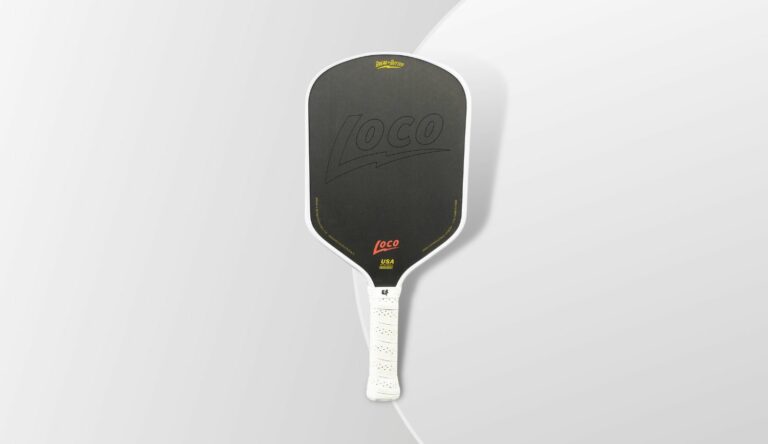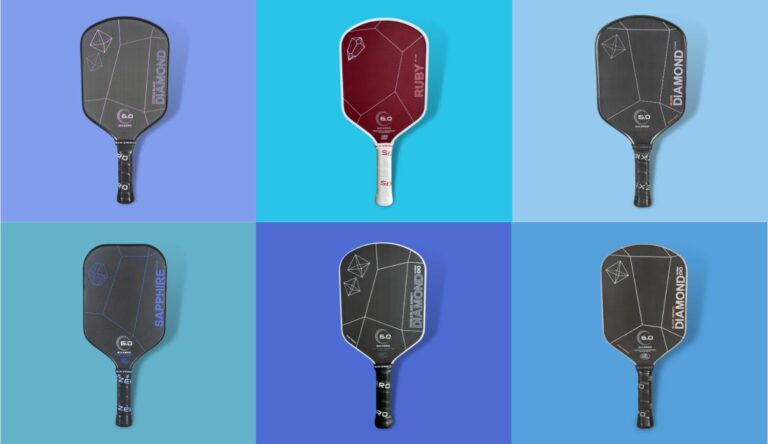Ronbus is always innovating and pushing paddle technology forward. Since their inception, Ronbus has released high-performing paddles with unique innovations at affordable prices. This is refreshing to see, as paddle prices are continually trending to obscene levels from the big paddle manufacturers.
Today, I have a new Ronbus paddle to talk about, the Pulsar FX. This new paddle is being released in three shapes (R1, R2, R3) and should be well-received among new and existing Ronbus fans.
The Pulsar FX is replacing the original Pulsar series. It continues the Gen 3 thermoforming paddle trend that Ronbus spearheaded with their prior release, the Nova line.
Like the Nova, the Pulsar FX series uses the same “edge-grid” technology that solved the crushed core/core corruption issues that plagued early thermoformed paddles while also improving the paddle’s dynamic response during play.
The Pulsar FX line also debuts a new patent pending flexible grid technology that bumps up power and spin output while extending dwell time for improved control.
I’ve extensively tested the new Pulsar FX line over the five weeks, utilizing all three shapes the line offers. I’ve really enjoyed my time with these paddles and am looking forward to compiling this review for you.
Contents
Ronbus Pulsar FX Technical Specifications
- Price:
$180($160 with code DASHPB) - Shape: Hybrid (R1), Wide-body (R2), Elongated-Standard (R3)
- Total length: 16.5″ (R1, R3), 16″ (R2)
- Width: 7.5″ (R1, R3), 8″ (R2)
- Core thickness: 16mm
- Surface: Raw Toray T700 Carbon Fiber
- Average weight: 8.2oz, +/- 0.2oz
- Grip length: 5.5″
- Grip size: 4.125″ Octagon
- Swing Weight: 114 (R2), 119 (R1), 122 (R3)
- Twist Weight: 6.22 (R1, R3), 6.95 (R2)
- Core: Polypropylene Honeycomb
Key Takeaways
The adjustments made to the FX over the original Pulsar paddle are noticeable and result in a more “connected” feeling to the ball. While I test and play with a lot of paddles, these Pulsar FXs are the ones that have called to me the most lately. I just love how they play overall.
The paddle is denser feeling and a tad heavier. Compared to the original Pulsar, you get more power, pop, control, and marginally more spin with the FX. I’ve found that the Pulsar FX paddles combine the best traits of the OG Pulsar and Nova series while further improving on them.
While it will be sad to see the original Pulsar line go, I feel that the FX line is a worthy successor. These are the best Ronbus paddles that I’ve ever played with. I really enjoy how solid the dwell time is and how well the FX paddles grab the ball, which I attribute to the flexible grid pattern Ronbus has introduced with this paddle line. And the new surface texture noticeably ups the spin output of the paddles.
The only potential drawback that I’ve noticed with the Pulsar FX series is weight, as my FXs all came in slightly heavier than my other Ronbus paddles at around 8.3oz. But the differences are marginal, and it’s only a problem if you prioritize light paddles. I personally still added some extra weight to my FXs, as I prefer a heavier paddle for added power and stability.
I’ve really enjoyed the addition of the R2 wide body shape in the FX line. The original Pulsar and Nova series didn’t come in this shape, and I think the R2 design will become very popular once people try it out. I usually use the elongated R3 shape for singles and the R1 shape for doubles, but the R2’s excellent sweet spot and smooth stability make it a highly appealing choice for doubles.
Power
The Pulsar FX line’s power output is high and on par for a thermoformed paddle. These are good paddles to use if you like to hit big, heavy drives with excellent plow-through. My overheads feel very potent and my drives and serves are very hot yet smooth and controlled. Counters and punch volleys pack great heat and stab/half-volleys really feel effortless for how much power they deliver.
If you already play with a Ronbus, you’ll notice that you get more power output from the FX paddles than the original Pulsar series and Nova series. The ball feels like it “trampolines” a little more than those paddles. Though the original R3 Pulsar might have the edge on the power output of the R2-shaped Pulsar FX. That said, the R2 Pulsar FX is the most powerful wide-bodied paddle that I’ve played with.
I do wish there were thinner options for these paddles, like a 14mm, 13mm, or even 12mm offering. A thinner Pulsar FX could more easily compete in power output with a Joola Gen 3 or Gearbox Power paddle.
Control
If a controllable feel is high on your priorities, then the Pulsar FX series is one of the better thermoformed options on the market. The FX’s new flexible carbon fiber grid feels really nice to hit with. The FX is very smooth, controlled, and responsive. My drops and resets feel buttery smooth with these paddles and have felt better than with any thermoformed paddle that I’ve played with this year. I didn’t need an adjustment period for my soft game with any of my FX paddles, though they did feel better as I broke them in over a few weeks of play.
The Pulsar FX paddles have this appealing plush sink-in feeling that makes you feel really connected to and in control of the ball. The way the ball sits on the face reminds me a bit of the Six Zero Ruby. The FX series also provides a lot of stability, certainly more than the original Pulsar, which I attribute to the carbon fiber grid. The sweet spot of these paddles is excellent, especially the R2 shape, which is basically all sweet spot.
With the great feel/stability and touch you have a lot of margin to work with on drops, dinks, blocks, and resets. These paddles really help my drops feel entirely consistent whenever I play with them. The only area that you might feel less control compared to other, lighter paddles, is at the net, where hand speed is tantamount to control.
Spin
All of Ronbus’s paddles feature top-tier spin output, and this hasn’t changed with the Pulsar FX. In fact, the FX line employs a new peel-ply texture on its carbon fiber face that improved spin in a way that I immediately noticed. I feel that I can be more aggressive with my topspin and underspin than I can with other Ronbus paddles, though the difference isn’t huge.
The ability to impart spin on my drives, drops, dinks, rolls, flicks with the Pulsar FX is right where I want it to be. My spin on flicks and speed-ups at the net are definitely improved over the OG Pulsar. With the FX, I feel like I have no problem attacking opponents with pretty wild angles that they need to adjust to, recognizing that my high-spin shots are going to stay in bounds. I’m hopeful that the new peel-ply will also have durability improvements, as a longer-lasting spin is always desirable.
Pop
I’ve noticed similar results in pop and speed on serves, counters, and punch volleys when swapping back and forth between the original Pulsar and Pulsar FX. The original Pulsar has a bit more crispiness overall due to the Pulsar FX having the new flexible carbon fiber grid that increases dwell time.
Overall, this is not a super high-pop paddle. But it is solid, nonetheless. With the FX you get the responsive dwell time that improves controllability while also feeling that your shots are crisp and energetic.
Hand speed
This is the one area where you sacrifice a little bit of performance compared to the original Pulsar. This is purely due to the weight, as the balance of the paddle is excellent.
If you don’t add weight to your paddles and just play them stock, then your hands might feel a little bit slower than normal when using the Pulsar FX. That is unless you already play with a heavier paddle. I personally play with a heavier paddle modified with lead tape, anyway, but the extra weight does result in slower wrist movements that can take away the disguise of your speed-ups at the net.
With that said, the Pulsar FX won’t have you lagging to the ball considerably. It’s not an ultralight paddle, but it’s also not that heavy. And the substantialness of the paddle really improves key areas like power and stability that are excellent components of this paddle. Just don’t expect it to be a total knockout in hands battles at the kitchen if you’re used to lighter-weight paddles.
Durability
Ronbus has excellent durability across their paddle line. I’ve played with and referred many Ronbus paddles and I’ve yet to hear any complaints in this department. Notably, the Pulsar FX series features Ronbus’s unique air-permeable edge grid, which solves the potential for durability issues inherent in the thermoforming process. This was originally introduced in their Nova line.
Value
Like all Ronubs paddles, the Pulsar FX comes at a solid price point for its performance. This is one of the better pickleball paddle companies on the market when it comes to cost-to-value. At $160 with a discount code, you can’t go wrong with the Pulsar FX.
Should you buy the R1, R2, or R3 Pulsar FX shape?
It’s exciting to be able to choose from three paddle shapes with this new line. When it comes to choosing the right paddle for you, you want to consider a few key performance areas.
R1 Pulsar FX – this is a hybrid-shaped offering that performs well across the board. It’s marginally more powerful than the R2 and slightly less than the R3. Its hand speed and pop output are also right in the middle between the two. Its sweet spot is slightly smaller than the R2 and slightly larger than the R3. This is a great all-arounder paddle shape that’s very popular for good reason.
R2 Pulsar FX – this wide body paddle is ideal for controllability and is the best standard shaped paddle for power on the market. It has a huge and forgiving sweet spot, is the largest of the group, and is also the most maneuverable of the bunch with its higher twist weight. Its stability is also amazing, making it a great choice for players who prioritize a paddle that supports and helps them limit detrimental mishits and keeps them moving fast at the kitchen. Its pop is also the highest due to it having the lowest swing weight.
R3 Pulsar FX – with its elongated shape, the R3 model is the best for power output, stability, and reach. This makes it the most ideal option for singles and for players who want power or need a little bit of extra reach. Just keep in mind that, due to its length, it is the least maneuverable of the three paddle shapes offered.
Overall, another well-made offering from Ronbus. Thanks to Dong and his team for making stellar paddles for us to use.
Be sure to add DASHPB coupon code at checkout for $20 off






